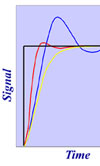Addressing the Envelope
 Today is the first of many strikes, or so we are told. The continuing dispute between management and unions in the Post Office has resulted in this, the first of a number of planned one-day stoppages across the UK on which the mere thought of reaching for an envelope and putting pen to paper is but the last thing on my mind. As engineers however, ‘addressing the envelope’ has an altogether different meaning. Other than a flat paper container with a sealable flap, to engineers an envelope is a containing structure or a boundary beyond which we stray only at our peril.
Today is the first of many strikes, or so we are told. The continuing dispute between management and unions in the Post Office has resulted in this, the first of a number of planned one-day stoppages across the UK on which the mere thought of reaching for an envelope and putting pen to paper is but the last thing on my mind. As engineers however, ‘addressing the envelope’ has an altogether different meaning. Other than a flat paper container with a sealable flap, to engineers an envelope is a containing structure or a boundary beyond which we stray only at our peril.
A perfect example of this is the engine dynamometer.
Coming in a variety of types, shapes and sizes, and surrounded by a certain amount of mystique by the outside worldwide, a dynamometer is simply a device to apply a load to an engine. A simple dynamometer can be nothing more than a crude mechanical brake applying a load to the rim of a flywheel. Attaching the load arm to some form of spring-balance or in engineering speak, load cell, and the maximum torque generated at a constant engine speed, can be quickly calculated. Multiply this by the speed of the engine speed in revolutions per minute and divide by a constant appropriate to the units in use, and the power of the engine at that particular speed can be readily determined. For a system such as this to be practical the heat from the friction in the brake would need to be cooled by a continuous supply of cooling water but essentially all engine dynamometers are only a variation on this simple theme.
Dynamometers can be hydraulic, electric or eddy current.
While early dynamometers were hydraulic, using a system of ‘sluices’ or buckets to control water flow in something akin to a simple gearbox torque converter, most steady state dynamometers today are of the eddy current type. Similar to an electric motor in some ways, an eddy current machine consists of a stator supported on free to rotate trunnion bearings and a rotor which is driven off the back of the engine. The rotor consists of a central hub from which thick rectangular section spokes project radially. Either side of the spinning rotor, smooth faced stationary loss plates can be found and surrounding these plates, is a large coil. All contained within a substantial steel casing, an AC current is passed through the coil (or coils if more than one is used), which produces a rapidly fluctuating magnetic field. The action of the spinning radial spokes interrupting the magnetic field induces eddy currents into the loss plates and the heating effect thus generated has to be cooled using a re-circulating water-based liquid passing through the many passageways machined into the plates. Shaft power from the engine is therefore resisted by the action of the eddy currents and totally converted into heat, which is carried away by the cooling system. Although controlled by the AC current, the dynamometer does not generate any current or voltage as would an electric version.
Like any rotating machine the absorption power envelope is limited on one hand by the torque, generated by the eddy currents, and then ultimately by the maximum safe speed of the rotor. Sometimes rotors can be cropped to increase their maximum speed but this also reduces the amount of torque absorption. Engine control however, should only be performed inside this operating envelope. Operating outside it will mean a possible loss of engine control and can therefore seriously damage your wallet.
Written by John Coxon.